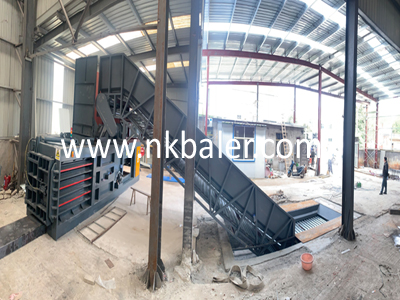The operating procedures for hydraulic baling machines mainly include preparations before operation,machine operation standards,maintenance procedures,and emergency handling steps.Here is a detailed introduction to the operating procedures for hydraulic baling machines:
Preparations Before Operation Personal Protection:Operators must wear work clothes before operating,fasten cuffs,ensure the bottom of the jacket is not open,and avoid changing clothes or wrapping cloth around themselves near the running machine to prevent machinery entanglement injuries.Additionally,safety hats,gloves,safety glasses,and earplugs among other protective gear must be worn.Equipment Inspection:Operators must be familiar with the main structure,performance,and usage methods of the baling machine.Before starting work,various debris on the equipment should be cleared,and any dirt on the hydraulic rod should be wiped clean.Ensure that the power supply is properly connected and all components of the hydraulic baling machine are intact without loosening or wearing.Safe Start-up:The installation of molds in the hydraulic baling machine device must be done with the power off,and bumping the start button and handle is prohibited.Before starting the machine,it is necessary to let the equipment idle for 5 minutes,check whether the oil level in the tank is sufficient,whether the sound of the oil pump is normal,and whether there is any leakage in the hydraulic unit,pipes,joints,and pistons.Machine Operation Standards Start-up and Shutdown:Press the power switch to start the equipment and select the appropriate working mode.When operating,stand at the side or back of the machine,away from the pressure cylinder and piston.After finishing,cut off the power,wipe the hydraulic rod of the press clean,apply lubricating oil,and organize neatly.
Baling Process Monitoring:During the baling process,stay alert,observe whether the items being packaged correctly enter the baling box,and ensure that the baling box does not overflow or burst.Adjust the working pressure but do not exceed 90% of the equipment’s rated pressure.Test one piece first,and only start production after passing inspection.Safety Precautions:It is strictly forbidden to knock,stretch,weld,or perform other operations while pressing.Smoking,welding,and open flames are not allowed around the working area of the hydraulic baling machine,nor should flammable and explosive items be stored nearby;fire prevention measures must be implemented.
Maintenance ProceduresRegular Cleaning and Lubrication:Clean the hydraulic baling machine regularly,including removing dust and foreign objects.According to the instructions,add an appropriate amount of lubricating oil to the lubrication points and friction parts of the hydraulic system.Component and System Check:Regularly inspect key components of the Fully automatic baler hydraulic baling machine such as pressure cylinders,pistons,and oil cylinders to ensure they are intact and securely fastened.Periodically check the electrical system’s wiring and connections for good condition to ensure the electrical system’s safety and normal operation.Emergency Situation Handling Power Outage Handling:If the hydraulic baling machine encounters an unexpected power outage during operation,immediately press the emergency stop button and ensure the machine has stopped before proceeding with other operations.Hydraulic System Leak Handling:If a leak is discovered in the hydraulic system,immediately shut down the equipment for repair or replacement of hydraulic components.Machine Jam Handling:If the machine is found unable to operate normally or is jammed,immediately stop the machine for inspection,use tools to clear the baled items if necessary,and then restart the machine.
Strictly following the operating procedures of the hydraulic baling machine is key to ensuring operational safety and normal equipment operation.Operators must undergo training and master the equipment’s performance and technology before working independently.Regular maintenance and care are also important measures to extend equipment lifespan and enhance safety awareness.
Post time: Jul-18-2024
